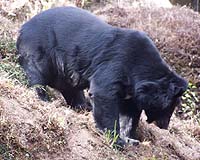| . |  |
. |
Ann Arbor MI (SPX) Sep 29, 2010 The more complex a plant or animal, the more difficulty it should have adapting to changes in the environment. That's been a maxim of evolutionary theory since biologist Ronald Fisher put forth the idea in 1930. But if that tenet is true, how do you explain all the well-adapted, complex organisms - from orchids to bower birds to humans - in this world? This "cost of complexity" conundrum puzzles biologists and offers ammunition to proponents of intelligent design, who hold that such intricacy could arise only through the efforts of a divine designer, not through natural selection. A new analysis by Jianzhi "George" Zhang and coworkers at the University of Michigan and Taiwan's National Health Research Institutes reveals flaws in the models from which the cost of complexity idea arose and shows that complexity can, indeed, develop through evolutionary processes. In fact, a moderate amount of complexity best equips organisms to adapt to environmental change, the research suggests. The findings will be published online in the Proceedings of the National Academy of Sciences. The study focused on a genetic phenomenon called pleiotropy, in which a single gene affects more than one trait. Examples of pleiotropy are well known in certain human diseases, and the effect also has been documented in experimental animals such as fruit flies. Biologists also recognize its importance in development, aging and many evolutionary processes. However, pleiotropy is difficult to measure, and its general patterns are poorly understood, said Zhang, a professor of ecology and evolutionary biology. Even so, scientists have developed mathematical models of the phenomenon, based on certain assumptions, and have made predictions from the results of the models. Zhang and coworkers decided to test the assumptions against real-life observations by analyzing several large databases that catalog the effects of specific genetic mutations on traits in model organisms (yeast, roundworms and mice). Each data set included hundreds to thousands of genes and tens to hundreds of traits. For simplicity, mathematical models of pleiotropy have assumed that all genes in an organism affect all of its traits to some extent. But Zhang's group found that most genes affect only a small number of traits, while relatively few genes affect large numbers of traits. What's more, they found a "modular" pattern of organization, with genes and traits grouped into sets. Genes in a particular set affect a particular group of traits, but not traits in other groups. In addition, the researchers learned that the more traits a gene affects, the stronger its effect on each trait. All of these findings challenge the assumptions underlying the classic mathematical models that suggest complexity is prohibitively costly. When Fisher first wrote about the cost of complexity, he argued that random mutations---which, along with natural selection, drive evolution---are more likely to benefit simple organisms than complex organisms. "Think of a hammer and a microscope," Zhang said. "One is complex, one is simple. If you change the length of an arbitrary component of the system by an inch, for example, you're more likely to break the microscope than the hammer." In a paper published in 2000, evolutionary geneticist H. Allen Orr of Rochester came up with additional reasons for the cost of complexity. According to his model, even if a mutation benefits a complex organism, it's unlikely to spread throughout the whole population and become "fixed." And even if it does that, the advantage of the mutation is likely to be small. By incorporating a more realistic representation of pleiotropy, Zhang's analysis found the reverse of Orr's arguments to be true. Although Fisher's observation still holds, reversing Orr's assertions minimizes its impact, thus reducing the cost of complexity. Further, the analysis showed that the ability of organisms to adapt is highest at intermediate levels of complexity. "This means a simple organism is not best, and a very complex organism is not best; some intermediate level of complexity is best in terms of the adaptation rate," Zhang said. The new findings help buffer evolutionary biology against the criticisms of intelligent design proponents, Zhang said. "The evolution of complexity is one thing that they often target. Admittedly, there were some theoretical difficulties in explaining the evolution of complexity because of the notion of the cost of complexity, but with our findings these difficulties are now removed."
Share This Article With Planet Earth
Related Links University of Michigan Darwin Today At TerraDaily.com
 Reformed hunter battles to save Bangladesh's wildlife
Reformed hunter battles to save Bangladesh's wildlifeSrimongal, Bangladesh (AFP) Sept 27, 2010 Sitesh Ranjan Deb says his transformation from hunter to conservationist was triggered 20 years ago when he was attacked by a Himalayan black bear while out stalking deer. Sitesh, from northeastern Bangladesh, stumbled on the sleeping beast. It lashed out, severely damaging his face and one eye, and only emergency surgery saved his life. During many long months of recovery, Sitesh decide ... read more |
|
| The content herein, unless otherwise known to be public domain, are Copyright 1995-2010 - SpaceDaily. AFP and UPI Wire Stories are copyright Agence France-Presse and United Press International. ESA Portal Reports are copyright European Space Agency. All NASA sourced material is public domain. Additional copyrights may apply in whole or part to other bona fide parties. Advertising does not imply endorsement,agreement or approval of any opinions, statements or information provided by SpaceDaily on any Web page published or hosted by SpaceDaily. Privacy Statement |